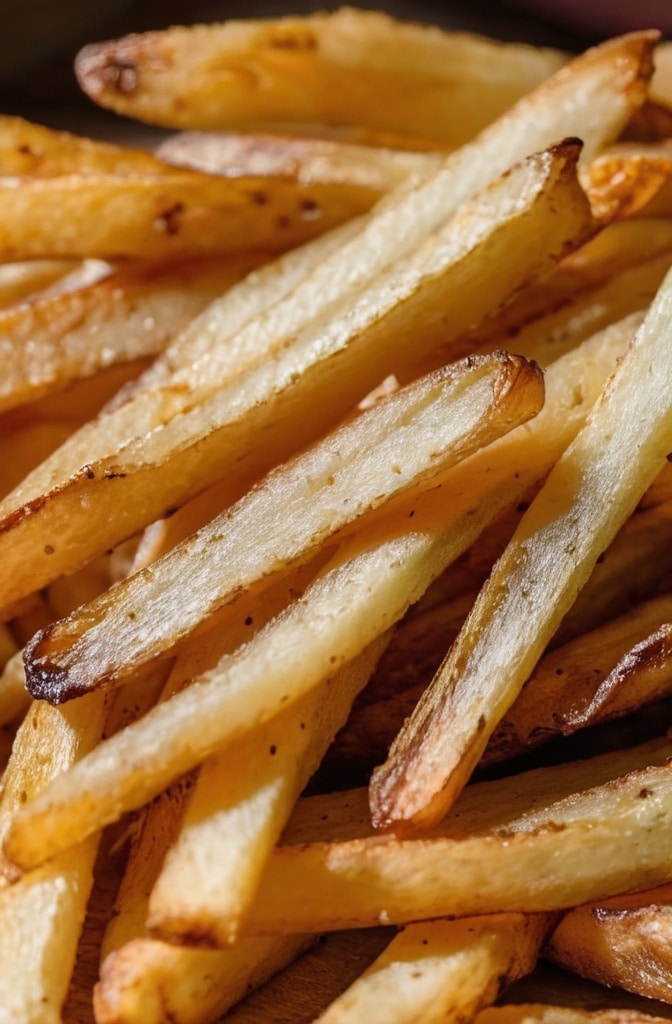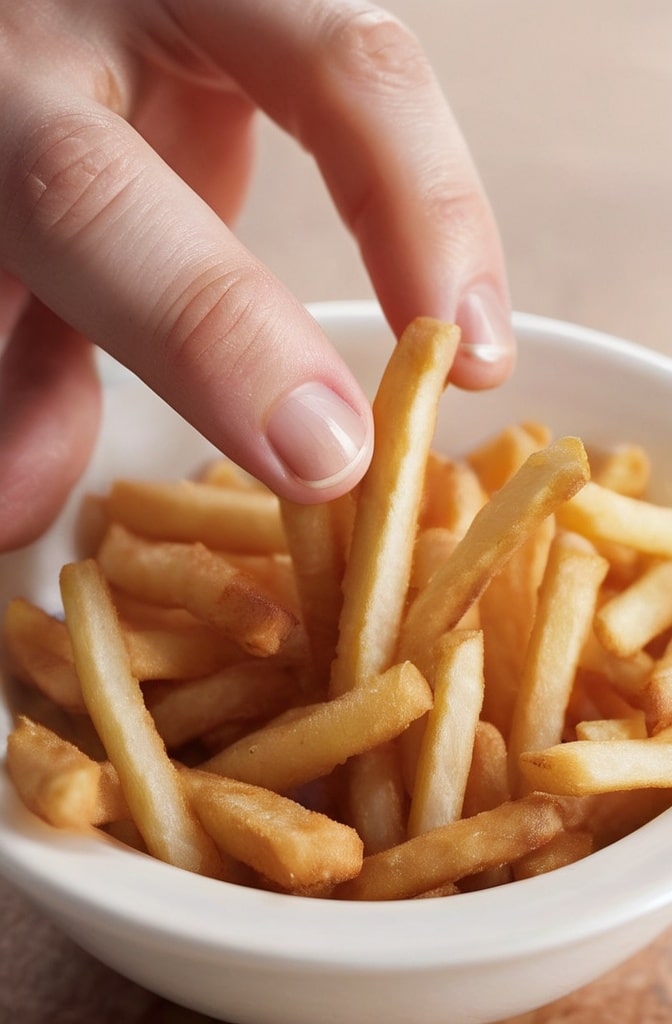The sizzle of potatoes hitting hot oil might be nostalgic, but let’s be real traditional deep-frying is a messy affair that leaves your kitchen smelling like a fast-food joint for days. I discovered Air Fryer French Fries after my doctor gave me the ‘cut back on fried foods’ lecture three years ago.
What started as a reluctant health compromise quickly became an obsession. These air-fried potatoes aren’t just “acceptable alternatives” they’re legitimately crispy on the outside, fluffy inside, and shockingly close to their deep-fried cousins.
Air fryer french fries represent the perfect intersection of technology and tradition. By circulating super-heated air around thinly cut potatoes, we can achieve that addictive crunch without submerging them in bubbling oil. The result? Fries with approximately 80% less fat that don’t sacrifice the textural contrast we crave.
As someone who’s tested over thirty variations in pursuit of the perfect fry, I’m excited to share the method that consistently delivers restaurant-quality results.
1. Ingredients & Substitutions
Primary Ingredients
- 2 large russet potatoes (about 1 pound)
- 1½ tablespoons olive oil
- ¾ teaspoon kosher salt
- ½ teaspoon garlic powder (optional)
- ¼ teaspoon black pepper
- ¼ teaspoon paprika (optional)
For Serving
- Additional salt to taste
- Favorite dipping sauces (homemade aioli, ketchup, etc.)
The humble russet potato reigns supreme in french fry applications due to its high starch content and low moisture. This specific composition creates that magical contrast between crispy exterior and fluffy interior. Yukon Gold potatoes make an acceptable substitute, offering a slightly buttery flavor, but expect less crunch. For a nutrient boost, sweet potatoes can work—just expect a softer texture and adjust cooking time down by about 2 minutes.
Olive oil provides a rich flavor foundation, but avocado oil delivers an even higher smoke point and neutral taste. Vegetable oil works fine too, tho it lacks the nutritional benefits. For those avoiding oil entirely, a light misting of oil from a spray bottle will suffice, but the texture will be noticeably different.
Salt choices matter more than most people realize. Kosher salt’s larger crystals adhere beautifully to the fries. Table salt works in a pinch but use about half the amount to avoid oversalting. Seasoned salt can replace all the spices listed for a quickie version with broad appeal.
2. Step-by-Step Instructions

Prep Work: The Foundation of Great Fries
- Scrub potatoes thoroughly but leave the skins on for extra texture and nutrients. Cut each potato into even ¼-inch thick sticks—uniformity is crucial for even cooking. I prefer slightly thicker fries (closer to ⅜-inch) for maximizing that fluffy interior.
- Place cut potatoes in a large bowl of cold water and soak for at least 30 minutes (or up to overnight in the refrigerator). This step removes excess starch, the secret to achieving maximum crispiness. Change the water once halfway through if soaking for more than an hour.
- Drain potatoes and pat them completely dry with paper towels or a clean kitchen towel. Residual moisture is the enemy of crispness—take time with this step. I sometimes spread them on a towel for ten minutes to air-dry further.
The Coating Process
- Transfer dried potatoes to a large mixing bowl. Drizzle with olive oil and toss to coat evenly. Many people make the mistake of adding seasoning before the oil, which leads to uneven distribution.
- Sprinkle with salt, pepper, garlic powder, and paprika (if using). Use your hands to mix thoroughly, ensuring each fry is evenly coated. This hands-on approach distributes seasonings far better than spoons or tongs.
Air Frying Method
- Preheat your air fryer to 380°F (193°C) for 3-5 minutes. Preheating is non-negotiable—cold air fryers create steamed rather than fried potatoes.
- Arrange seasoned potato sticks in a single layer in your air fryer basket, leaving small spaces between pieces. Overcrowding is the most common mistake; work in batches if necessary. Better to cook twice than have soggy fries.
- Cook for 12-15 minutes, pausing to shake the basket vigorously every 4-5 minutes. This redistribution ensures all sides crisp evenly. If your air fryer model cooks unevenly, consider rotating the basket 180° halfway through cooking.
- For maximum crispiness, increase temperature to 400°F (204°C) for the final 3 minutes. This temperature burst creates that golden-brown finish that makes fries irresistable. Watch closely during this final stage to prevent burning.
- Test for doneness by selecting a thick fry and breaking it open—it should be fluffy inside with no resistance. Transfer to a serving bowl lined with paper towels to absorb any excess oil.
3. Cooking Techniques & Science
The science behind perfect air fryer french fries involves three critical principles: starch reduction, moisture management, and the Maillard reaction. Soaking potatoes removes surface starch, which otherwise inhibits crisp texture formation. Think of starch as a moisture-trapping barrier—by reducing it, we allow proper dehydration of the exterior while maintaining interior moisture.
Air fryers work by circulating extremely hot air (usually 350-400°F) at high velocity. Unlike conventional ovens, this creates a “micro-environment” around each fry similar to immersion in hot oil. The rapid air movement accelerates moisture evaporation from the surface while transferring heat to the interior at a controlled rate. This precise heat control is why air fryers succeed where conventional ovens often fail.
The key transformation happens through the Maillard reaction—a complex chemical process occuring when amino acids and reducing sugars are heated together. This reaction creates hundreds of different flavor compounds and that characteristic golden-brown color. It begins around 280°F but accelerates dramatically above 320°F, which is why that final temperature boost produces such dramatic results.
Shaking the basket isn’t just busywork—it’s essential for even cooking. The bottom of the air fryer basket receives more direct heat than the top, creating temperature gradients. Regular redistribution ensures all surfaces receive equal heat exposure. For especially crispy results, some professional kitchens actually chill the cut, dried potatoes before air frying, creating greater temperature differential between exterior and interior.
4. Troubleshooting Common Issues
Despite the simplicity of this recipe, several pitfalls can compromise your results. If your fries emerge soggy, insufficient drying is usually the culprit. Moisture creates steam, and steam is the enemy of crispiness. Try patting dry twice or even briefly using a salad spinner after soaking.
Uneven cooking typically results from overcrowding or inconsistent sizing. Each fry needs space for air circulation—cook in batches rather than cramming too many in at once. Use the largest air fryer basket your model offers, and consider investing in a double-layer rack accessory for increased capacity.
Burning occurs most commonly when fries are too thin or the air fryer runs hot. Not all air fryers are calibrated accurately—some may run 15-25 degrees hotter than indicated. For your first batch, check 2 minutes earlier than recommended and adjust accordingly.
5. Serving & Pairing Suggestions
Serve these crispy wonders immediately after cooking—air fried fries waits for no one and begins losing crispness after about 7 minutes. Transfer to a serving vessel lined with a small square of parchment paper rather than paper towels to maintain texture during serving.
For presentation worthy of Instagram, serve in a small metal basket lined with parchment, sprinkled with flaky sea salt and finely chopped fresh herbs (parsley adds beautiful color contrast). A slate serving board provides dramatic background for food photography enthusiasts.

Classic ketchup never disappoints, but homemade dipping sauces elevate these fries to gourmet status. Try truffle aioli (mayonnaise, minced garlic, truffle oil, lemon juice), smoky chipotle mayo, or herb-loaded ranch dressing. For European flair, serve with mayonnaise spiked with dijon mustard.
These fries pair beautifully with grilled proteins—the acidic brightness of a well-made burger cuts through the starchy satisfaction of perfectly cooked fries. For a lighter meal, serve alongside grilled fish with lemon wedges. Wine enthusiasts should consider a crisp Sauvignon Blanc or, for beer lovers, a hoppy IPA that contrasts nicely with the fries’ salty appeal.
6. Variations to Explore
Once you’ve mastered the basic technique, experiment with these elevated variations:
Garlic Parmesan Fries: Toss hot fries with 2 tablespoons grated Parmesan, 1 teaspoon garlic powder, and 1 tablespoon chopped parsley immediately after cooking. The residual heat melts the cheese perfectly.
Spicy Cajun Fries: Replace the standard seasoning with 1 tablespoon of Cajun seasoning. For homemade Cajun blend, combine paprika, cayenne, garlic powder, onion powder, dried oregano, and thyme.
Truffle Fries: After cooking, drizzle fries with 1-2 teaspoons of truffle oil and sprinkle with finely grated Parmesan and minced parsley. A little truffle oil goes a long way—start with less than you think you need.
Sweet Potato Curry Fries: Substitute sweet potatoes and season with 1 teaspoon curry powder, ¼ teaspoon cinnamon, and a pinch of cayenne. Serve with curry-spiced yogurt dip for an exotic twist.
7. Make-Ahead and Storage Tips
While freshly made fries offer optimal texture, preparation steps can be done in advance. Cut potatoes can be stored in water in the refrigerator for up to 24 hours. For busy weeknights, complete the soaking and drying steps earlier in the day, then store dried, cut potatoes in an airtight container with a paper towel to absorb any residual moisture.
Leftover fries—should you have any—can be stored in the refrigerator for up to 3 days. To reheat, avoid the microwave (which creates soggy results). Instead, return them to the air fryer at 380°F for 3-4 minutes. This brief reheating restores much of their original crispness.
For batch cooking, partially cook fries for 10 minutes, cool completely, then freeze in a single layer on a baking sheet before transferring to freezer bags. These partially-cooked fries can be finished directly from frozen (no thawing) by air frying at 400°F for 5-7 minutes.
Conclusion
The perfect air fryer french fry represents culinary science at its most accessible. By understanding the crucial techniques—proper cutting, thorough soaking and drying, adequate spacing, and temperature control—anyone can create restaurant-quality fries with significantly less fat than traditional methods.
What makes these particular air fryer french fries special isn’t just their crispy exterior and fluffy interior, but the way they’ve been perfected through methodical testing. Each step addresses specific scientific principles that transform humble potatoes into crave-worthy fries. Whether you’re serving them alongside burgers at a casual gathering or as part of a more refined meal with homemade aioli, these fries deliver consistent satisfaction.
Remember that air fryer models vary significantly in power and design. Your first batch serves as a calibration—note the exact timing needed for your preferred level of crispness, then adjust future batches accordingly. The journey to french fry perfection is personal, and your air fryer’s quirks become part of your unique cooking signature.
FAQs About Air Fryer French Fries Recipe
Q: Can I skip the soaking step if I’m short on time?
A: Technically yes, but results will suffer significantly. If absolutely necessary, rinse cut potatoes under cold running water for 2 minutes, stirring constantly with your hands. This removes some surface starch but doesn’t match the effectiveness of a proper soak.
Q: Why are my fries browning too quickly but still raw inside?
A: This typically indicates your air fryer runs hot or your fries are cut too thinly. Try reducing temperature by 15-20°F and cutting slightly thicker fries (aim for ⅜-inch thickness). Also ensure you’re not using potatoes with high sugar content, which browns faster.
Q: Is parchment paper safe in an air fryer?
A: Yes, with important caveats. Use only parchment specifically designed for air fryers (with perforations), place it after preheating (never during), and ensure it’s weighted down by food. Never let it touch heating elements, and never use wax paper as a substitute.
Q: My air fryer basket is small. Can I stack the fries?
A: Single-layer cooking produces the best results, but if necessary, you can stack lightly (not more than two layers) if you increase shaking frequency to every 3 minutes. Expect slightly longer cooking times and somewhat less uniform crispness.
Q: How can I make my fries even crispier without adding oil?
A: Sprinkle ½ teaspoon cornstarch on dried potatoes before air frying. The cornstarch creates an ultra-thin coating that crisps beautifully. For extra crunch without oil, you can also try a very light spritz of apple cider vinegar before cooking, which helps the exterior dehydrate more effectively.

